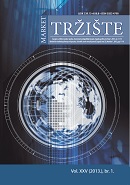Kruške i jabuke prikrivenog oglašavanja: razlučivanje i terminološko određenje korištenja marki u programskim sadržajima
Apples and oranges in disguised advertising: differentiation and terminological determination of brand usage in program content
Author(s): Andrea Muškinja, Ivana First KomenSubject(s): Economy
Published by: CROMAR (Hrvatska zajednica udruga za marketing) i Ekonomski fakultet Zagreb
Keywords: disguised advertising; product placement; brand usage in program contents; brand placement
Summary/Abstract: Disguised advertising is a modern marketing instrument that is seeing an increase in Croatian business practice but whose application is prohibited by Croatian law. Therefore, the purpose of this study is to understand whether Croatian businesses really do use disguised advertising, how they do it either in accordance or in contradiction with Croatian law, and whether there is a need to distinguish among several similar but different manifestations and to terminologically determine each one of these. For the purpose of this study, we explored the theoretical, legal and ethnographic conceptualizations of the term disguised advertising in the scientific literature, Croatian legislation and applied communication in business practice. The results of our research show that: a) marketing literature uses various terms for describing brand usage in program content, among which disguised advertising (prikriveno oglašavanje) dominates, whereas product placement (plasman proizvoda) is not mentioned once; b) the law distinguishes between disguised advertising that is prohibited and product placement, as a practise allowed under certain conditions and the one that is by definition identical with disguised advertising in the manner defined by marketing literature; c) business entities in their communication make a distinction between disguised advertising and product placement, and they are trying to move product placement away from disguised advertising by being mentioned as sponsors/partners of the program. The analysis also indicates three different situations in which brands are used in the program content: contracted and correctly indicated brand usage; contracted but not indicated; and not-contracted brand usage. Only the first situation is considered to be a recommended marketing tool; therefore, it is necessary to differentiate it from the other two by its definition and name. It is suggested that this marketing tool be named: brand placement in both marketing literature and legislation, as English literature already recommends. In the long term, this should lead to a proper use of the term in business practice as well.
Journal: MARKET/TRŽIŠTE
- Issue Year: 25/2013
- Issue No: 1
- Page Range: 51-62
- Page Count: 12
- Language: Croatian

